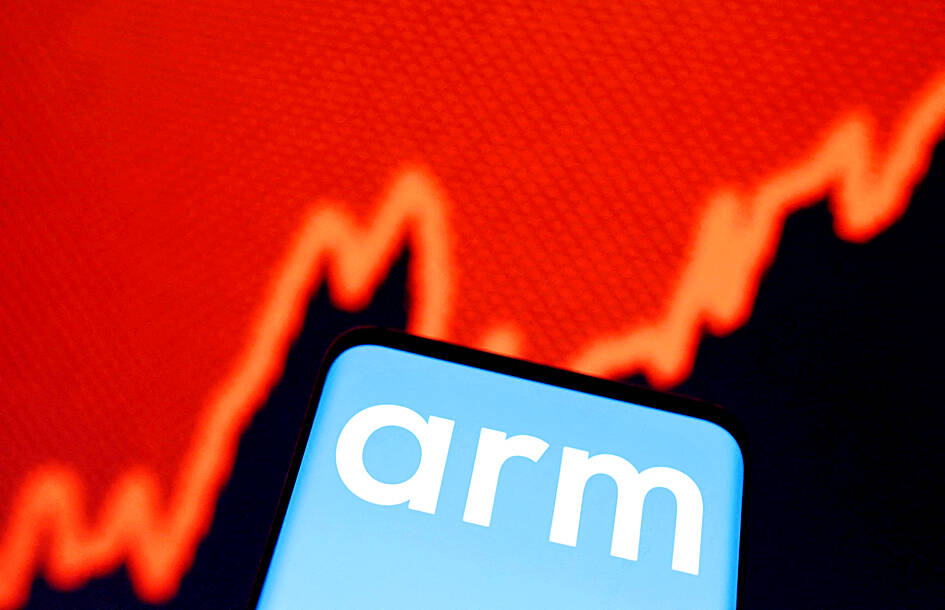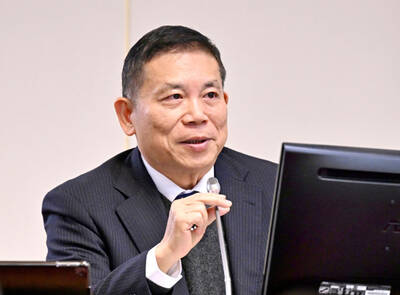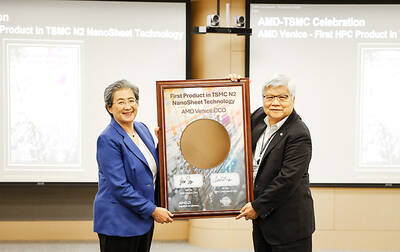British chip designer Arm Ltd, backed by Softbank Group Corp, is in talks with potential strategic investors including Intel Corp to anchor what is expected to be one of the largest initial public offerings (IPOs) of the year, people familiar with the matter said.
Arm has held talks with other companies about participating in the IPO, the people said, asking not to be identified because the matter is private.
The talks are early and could still fall apart ahead of the listing, the people added.

Photo: Reuters
It is also unclear how much would be invested in Arm or what the structure would be.
Arm is looking to raise as much as US$10 billion in its listing in New York later this year, Bloomberg News previously reported.
Representatives for Intel and Arm declined to comment.
Bringing on an anchor investor in an IPO can help drum up interest and momentum, especially in a rough market for new listings. If the talks succeed, Intel would eventually be listed in Arm’s IPO prospectus ahead of the listing.
Anchor investors buying US$100 million to US$200 million worth of shares have been popular for semiconductor-related IPOs in the past few years. Growth equity firm General Atlantic invested about US$100 million in Intel-backed Mobileye Global Inc’s IPO last year, while Qualcomm Inc backed GlobalFoundries Inc’s listing in 2021.
A key part of Intel chief executive officer Pat Gelsinger’s push to return the company to the pinnacle of the semiconductor industry is a plan to open up its factories to other firms, even rivals. If he is to be successful in competing with Taiwan Semiconductor Manufacturing Co (台積電) in outsourced production, Intel would have to produce chips that contain Arm’s widely used technology.
The two have already announced a technical tie-up. Arm’s designs and industry-standard instruction set are used in everything from Broadcom Inc networking chips to Apple Inc processors in the iPhone and Macs to Qualcomm Inc’s ubiquitous chips for mobile phones.
By taking a position in Arm, whose technology has enabled direct competition for Intel’s processors, Gelsinger might be seeking to show his commitment to Arm and to embracing that openness. Throughout its more than 50-year history, Intel’s plants have almost exclusively worked on its own designs.
Softbank founder Masayoshi Son has said he hopes the Arm IPO can be the largest ever by a chip company.
Arm’s valuation still has not been set and the company could be valued anywhere from US$30 billion to US$70 billion, Bloomberg News previously reported.

Taiwan will prioritize the development of silicon photonics by taking advantage of its strength in the semiconductor industry to build another shield to protect the local economy, National Development Council (NDC) Minister Paul Liu (劉鏡清) said yesterday. Speaking at a meeting of the legislature’s Economics Committee, Liu said Taiwan already has the artificial intelligence (AI) industry as a shield, after the semiconductor industry, to safeguard the country, and is looking at new unique fields to build more economic shields. While Taiwan will further strengthen its existing shields, over the longer term, the country is determined to focus on such potential segments as

UNCERTAINTY: Innolux activated a stringent supply chain management mechanism, as it did during the COVID-19 pandemic, to ensure optimal inventory levels for customers Flat-panel display makers AUO Corp (友達) and Innolux Corp (群創) yesterday said that about 12 to 20 percent of their display business is at risk of potential US tariffs and that they would relocate production or shipment destinations to mitigate the levies’ effects. US tariffs would have a direct impact of US$200 million on AUO’s revenue, company chairman Paul Peng (彭雙浪) told reporters on the sidelines of the Touch Taiwan trade show in Taipei yesterday. That would make up about 12 percent of the company’s overall revenue. To cope with the tariff uncertainty, AUO plans to allocate its production to manufacturing facilities in

COLLABORATION: Given Taiwan’s key position in global supply chains, the US firm is discussing strategies with local partners and clients to deal with global uncertainties Advanced Micro Devices Inc (AMD) yesterday said it is meeting with local ecosystem partners, including Taiwan Semiconductor Manufacturing Co (TSMC, 台積電), to discuss strategies, including long-term manufacturing, to navigate uncertainties such as US tariffs, as Taiwan occupies an important position in global supply chains. AMD chief executive officer Lisa Su (蘇姿丰) told reporters that Taiwan is an important part of the chip designer’s ecosystem and she is discussing with partners and customers in Taiwan to forge strong collaborations on different areas during this critical period. AMD has just become the first artificial-intelligence (AI) server chip customer of TSMC to utilize its advanced

While China’s leaders use their economic and political might to fight US President Donald Trump’s trade war “to the end,” its army of social media soldiers are embarking on a more humorous campaign online. Trump’s tariff blitz has seen Washington and Beijing impose eye-watering duties on imports from the other, fanning a standoff between the economic superpowers that has sparked global recession fears and sent markets into a tailspin. Trump says his policy is a response to years of being “ripped off” by other countries and aims to bring manufacturing to the US, forcing companies to employ US workers. However, China’s online warriors